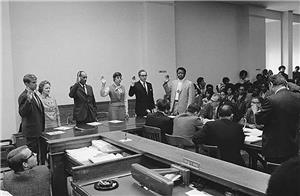On May 15, 1970, Seattle Police shoot and kill Larry Eugene Ward (1947-1970) as he flees after setting a bomb in the Central Area. Ward is not the "Central Area Bomber" responsible for a rash of bombings. Rather, he has been recruited for this job by a police informer only shortly before. A coroner's inquest hears evidence on the shooting and hands down a non-unanimous verdict of "death by criminal means."
The Set-up
Seattle Police had been alerted to the attempt by the FBI and had established a surveillance of Hardcastle Realty at 23rd Avenue and Union Street expecting Black Panther leader Curtis Harris. Ward arrived at the scene in a car driven by Alfred Rudolph "Alfie" Burnett. Burnett was an ex-convict, pending charges for armed robbery who also provided police with information. When Ward was observed attempting to light the fuse, police moved in and Ward fled. Officer John Hannah fired several rounds from a shotgun and Ward was killed. Ward was a Vietnam veteran, wounded in combat, and had been out of the U.S. Army for two months.
Aftermath
The coroner's inquest was characterized by disruptive protests and by attempts by lawyers for Ward's family to cross-examine witnesses. The jury rendered its verdict of "death by criminal means" with a vote of 3-2 (one member was excused). Later, this verdict was thrown out because it was not unanimous. The prosecuting attorney declined to file criminal charges in the matter.
A civil suit on behalf of Ward's minor son seeking $1 million in damages each from Officer Hannah, Police Captain John Williams, and Burnett was filed in federal court, alleging conspiracy and wrongful death. In January 1975, the case went to trial. Burnett failed to appear in court and the judge dismissed the case against Williams. The jury found in favor of Officer Hannah.
In 1978, Seattle changed its police shooting policy, but the new policy still permitted the shooting of someone fleeing the scene of a dangerous felony such as a bombing.

